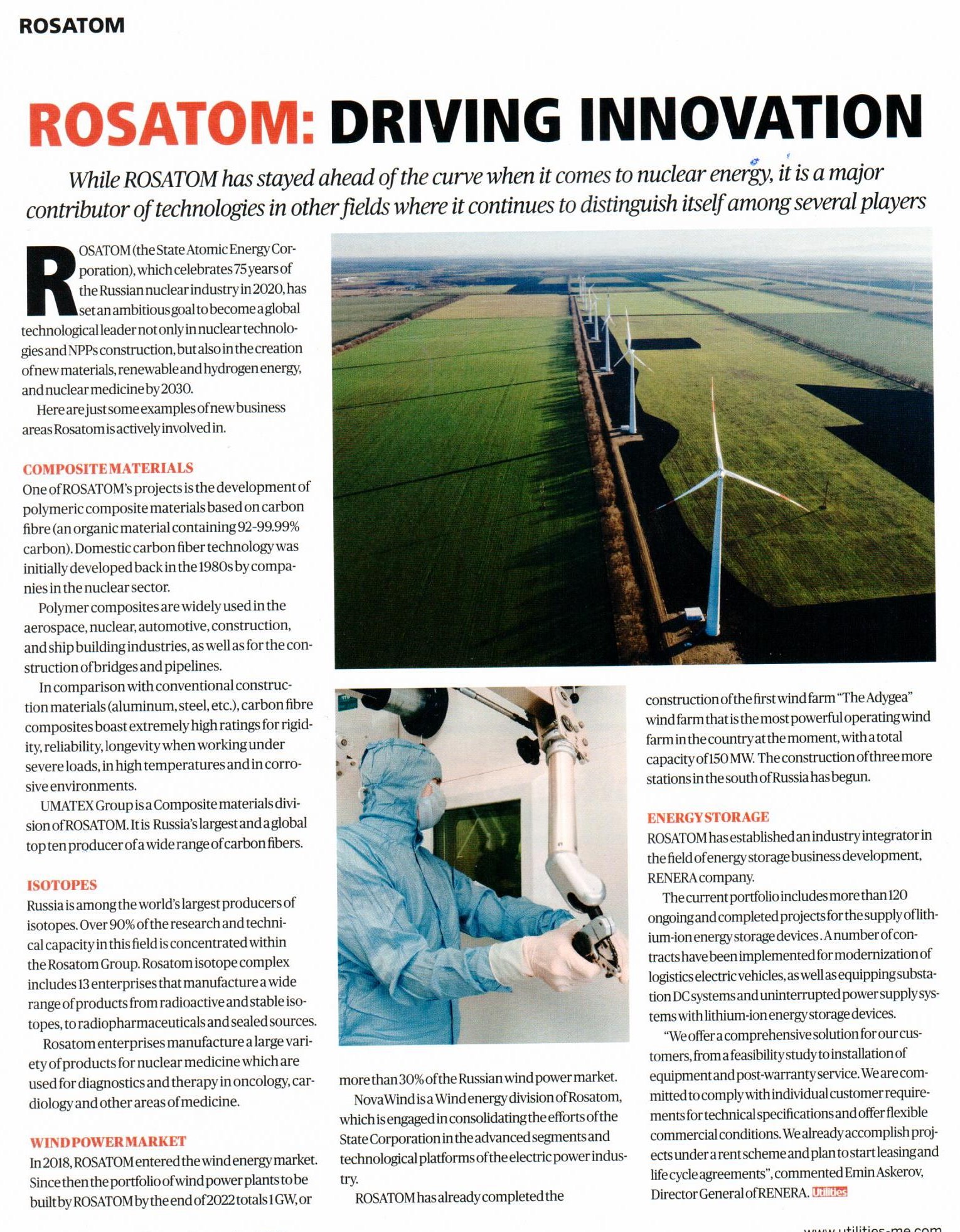ROSATOM: Driving Innovation

While ROSATOM has stayed ahead of the curve when it comes to nuclear energy, it is a major contributor of technologies in other fields where it continues to distinguish itself among several players Rosatom.
ROSATOM (the State Atomiс Energy Corporation) continues to be the main driver for nuclear energy success in the world and a global technological leader that has stayed ahead of the curve when it comes to the state-of the-art nuclear technologies. But besides driving progress in nuclear energy, ROSATOM is also a major contributor of technologies in other fields where it continues to distinguish itself among several players.

While ROSATOM has stayed ahead of the curve when it comes to nuclear energy, it is a major contributor of technologies in other fields where it continues to distinguish itself among several players Rosatom.
ROSATOM (the State Atomiс Energy Corporation) continues to be the main driver for nuclear energy success in the world and a global technological leader that has stayed ahead of the curve when it comes to the state-of the-art nuclear technologies. But besides driving progress in nuclear energy, ROSATOM is also a major contributor of technologies in other fields where it continues to distinguish itself among several players.
COMPOSITE MATERIALS
One of ROSATOM’s projects is the development of polymeric composite materials based on carbon fibre (an organic material containing 92–99.99% carbon). Domestic carbon fiber technology was initially developed back in the 1980s by companies in the nuclear sector. In comparison with conventional construction materials (aluminum, steel, etc.), carbon fibre composites boast extremely high ratings for rigidity, reliability, longevity when working under severe loads, in high temperatures and in corrosive environments. We are now able to produce carbon composites that are 10 times stronger and 5 times lighter than steel. These materials are essential in load bearing structures where it is critical to increase strength while reducing weight.
Polymer composites are widely used in the aerospace, nuclear, automotive, construction, and ship building industries, as well as for the construction of bridges and pipelines. ISOTOPES Russia is among the world’s largest isotopes’ producers. Over 90% of the research and technical capacity in this field is concentrated within the Rosatom Group. Rosatom isotope complex includes 13 enterprises that manufacture a wide range of products from radioactive and stable isotopes, to radiopharmaceuticals and sealed sources. Rosatom enterprises manufacture a large variety of products for nuclear medicine: isotopes Mo-99, I-131, I-125, Lu-177, Sr-89, Ac-225, radiopharmaceuticals I-131, Sm-153, Ga-67, as well as generators of short-lived isotopes Tc-99m, Re-188 etc., which are used for diagnostics and therapy in oncology, cardiology and other areas of medicine.
NUCLEAR MEDICINE MARKET
In 2019, the global nuclear medicine market totalled USD 13.2 billion and is expected to reach USD 33.3 billion by 2030, with the shares of equipment and radiopharmaceuticals production almost equal in monetary terms. ROSATOM sees considerable potential for the development of nuclear medicine services for the general public. The Corporation has initiated projects to create a network of radionuclide therapy and nuclear medicine centres in Russia and abroad, which will provide high-quality healthcare services to patients.
ROSATOM is the largest supplier of isotopes and radiopharmaceuticals for nuclear medicine in Russia. About 40% of the world’s reactor units producing medical radioisotopes are located in Russia. The Corporation accounts for 25% to 40% of global radioisotope production (depending on the types of radioisotope products). The Corporation’s long-term goal is to rank third on the international market in terms of revenue.
WIND POWER MARKET
In 2018, ROSATOM entered the wind energy market. ROSATOM’s experts assess that by 2024 its volume may be 3.6 GW and the annual turnover will be US $1.6bn. This guarantees the demand for production of wind turbines (WTs) and entire wind farms, necessary infrastructure and technical support services. Altogether, this is evaluated at US $6.3bn. Rosatom is engaged in the implementation of renewable energy projects and is convinced that nuclear power and other types of low-carbon generation - in particular, solar, wind and hydro power - not only do not compete with each other, but complement each other.
JSC NovaWind is a wind energy division of Rosatom, which is engaged in consolidating the efforts of the State Corporation in the advanced segments and technological platforms of the electric power industry. ROSATOM has already completed the construction of the first wind farm “The Adygea” wind farm that is the most powerful operating wind farm in the country at the moment, with a total capacity of 150 MW.
ENERGY STORAGE
ROSATOM has completed incorporation of the nuclear industry integrator company for energy storage business development. RENERA is incorporated on the basis of Cathode Materials LLC, an enterprise of TVEL Fuel Company of ROSATOM. The company will develop and trade module type lithium-ion traction batteries for electric vehicles, as well as energy storage systems for emergency power supply, renewable energy resources and smoothing load demand. The current portfolio includes more than 120 ongoing and completed projects for the supply of lithium-ion energy storage devices (contracts previously concluded by a number of TVEL enterprises - Cathode Materials, NPO Centrotech and Novosibirsk Chemical Concentrates Plant). A number of contracts have been implemented for modernization of logistics electric vehicles, as well as equipping substation DC systems and uninterrupted power supply systems with lithium-ion energy storage devices.
The original article is here.
